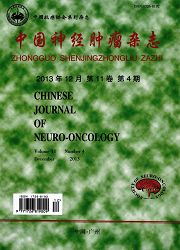

 中文摘要:
中文摘要:
背景与目的:细胞黏附分子L1(cell adhesionmoleculeL1,L1CAM)是一种跨膜黏附蛋白,在神经系统发育及肿瘤发生中发挥重要作用。本研究运用RNA干扰(RNAinterference,RNAi)技术抑制L1CAM表达,并探讨其对胶质瘤U251细胞多药耐药的逆转作用及相关分子机制。方法:将针对L1CAM的小干扰RNA(siLl)和阴性对照siRNAfsiCon)转染人胶质瘤U251细胞。实验分3组:空白对照组(胶质瘤U251细胞)、阴性对照组(转染siCon的胶质瘤U251细胞)、实验组f转染siLl的胶质瘤U251细胞)。蛋白质印迹法(Westernblotting)~U251细胞中L1CAM、MRPl、pAKT及pERK1/2等蛋白表达。细胞增殖实验检测L1CAM对顺铂(cisplatin)和P13K/AKT抑制剂LY294002抑制U251细胞增殖的影响。免疫荧光染色法检测抑制LICAM表达对U251细胞系中AKT磷酸化情况的影响。结果:实验组L1CAM、pAKT.pERKl/2蛋白表达量明显低于阴性对照组和空白对照组(P〈0.01),但实验组多药耐药蛋白MRPl表达量以及Bcl-2cdBax与阴性对照组和空白对照组相比无明显变化。实验组顺铂和LY294002对U251细胞增殖的抑制率高于阴性对照组和空白对照组,提示抑制LICAM表达后细胞对顺铂和LY294002的敏感性增加。免疫荧光结果显示,与阴性对照组和空白对照组相比,实验组细胞内AKT磷酸化信号明显降低。结论:RNAi抑制L1CAM表达能增强顺铂和LY294002对U251细胞增殖的抑制作用,并可抑制P13K/AKT和MAPK信号激活.一定程度上可逆转胶质瘤细胞的多药耐药性。
 英文摘要:
英文摘要:
BACKGROUND & OBJECTIVE: Cell adhesion molecule L1 (L1CAM) is a transmembrane cell adhesion protein and play an important role in nervous system development and tumorigenesis. In the present study, we aimed to investigate the effect of RNA interference targeting cell adhesion molecule L1 (L1CAM) on the multidrug resistance of human glioma U251 cells and clar/(y the related molecular mechanism. METHODS: The small interfering RNA (siRNA) targeting L1CAM and the control siRNA were respectively transfeeted into human glioma U251 cells. Three groups were included, including cells transfected with either siRNA targeting L1CAM (siLl) or control siRNA (si-Con) and cells without transfection as the blank control. Western blot analysis was undertaken to evaluate the effects of L1 on chemoresistance protein MRP1, related cell signaling pathways and apoptosis factors. The drug susceptibility of U251 cells to cisplatin and LY294002 (the inhibitor of phosphatidylinositol 3-kinase) was determined by cell proliferation assay. The phosphorylation of AKT in U251 cells was also detected by immunofluorescence staining. RESULTS: The expression of L1CAM, pAKT and pERK1/2 were both significantly reduced in the U251 ceils transfected with siRNA than those in the negative or blank control cells (P〈0.01). Flowever, there was not a significant difference in the expression of MRP1 and Bcl-2c~ / Bax among three groups. The proliferation inhibitory rates of cisplatin and LY294002 in U251 ceils transfected with siLl were higher than those of the negative or blank control ceils. In U251 ceils transfection with siLl resulted in a weaker staining of pAKT when compared to that in the negative and blank control cells. CONCLUSION: The down-regulation of LICAM expression by RNA interference can enhance the effects of cisplatin and LY294002 on inhibiting cell proliferation and activation of the PI3K and MAPK signaling pathway in the U251 cells, which may partially reverse the multidrug resistance of glioma cell
 同期刊论文项目
同期刊论文项目
 同项目期刊论文
同项目期刊论文
 Neuregulin-1 (Nrg1) is mainly expressed in rat pituitary gonadotrope cells and possibly regulates pr
Neuregulin-1 (Nrg1) is mainly expressed in rat pituitary gonadotrope cells and possibly regulates pr 期刊信息
期刊信息
